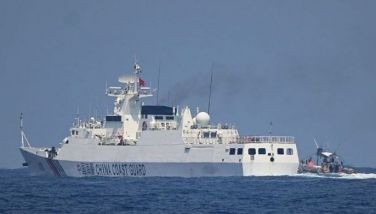Aboitizes almost bade shipping goodbye due to losses
DAVAO CITY , Philippines – Aboitiz Equity Venture (AEV) president and chief executive officer Erramon Aboitiz said that before the SuperFerry 9 tragedy last Sunday which claimed the lives of nine people, the Aboitiz Transport System Corp. was supposed to have already been bought by a foreign firm but its sale did not push through last April.
“Last year a foreign company offered to buy it. They were supposed to pay us last April but the payment did not push through,” Aboitiz said.
Aboitiz Transport System Corporation is one of the various companies under the AEV which has interests mostly in power, banking and food.
The ATSC’s botched sale was supposed to pave the way for the Aboitizes to concentrate more on their other investments, particularly on power generation and distribution.
Sixty-six percent of AEV investments are on power, while transportation ranks lowest at fourth, next to banking and food.
In September last year, the AEV reportedly accepted the unsolicited offer of the Dutch firm KGLI-NM Holdings to buy ATSC.
“But the payment did not push through last April because of the current problems in the debt markets,” Aboitiz said.
However, in spite of the botched sale, Aboitiz insisted that SuperFerry vessels are safe.
“ Our vessels are very safe. The safety of our vessel has always been our top priority,” Aboitiz further said.
He gave assurances that their other fleets are safe.
The fact that the Aboitiz Group remains the owner of the ill-fated SuperFerry 9 is a testimony to how the global financial crunch has hit one of the country’s biggest capitalists.
Almost a year ago – Sept. 23, to be exact – the Aboitiz Group was poised to exit the inter-island ferry business.
Several renegotiations after – in terms of purchase price, financial terms, size of stake – the buyer, a Filipino-Kuwaiti joint venture, called the deal off.
The buyer cited “current constraints in the debt markets” as the reason for its decision.
At the time, the financial markets were just starting to unfreeze in the aftermath of the thunderous fall of financial giants AIG, Lehman Brothers, and others that came after.
The road to April 30
When the Aboitiz Group announced on Sept. 23 that they were selling their stake in ATSC, formerly WG&A, the deal was marked as a milestone in Philippine business.
ATSC had its beginnings in 1907, a few years after the first generation of the Aboitiz family, who were migrants from northern Spain, settled in central Philippines. Ramon Aboitiz then bought the first vessel, a two-engine steamer, to transport abaca from Visayas to Manila.
For over 100 years, ATSC had been in the hands of up to the third and fourth generation of Aboitizes. Under ATSC are its carrier brands, SuperFerry, which provides inter-island sea travel; SuperCat, which offers fast craft passenger travel, and; 2GO, which offers freight and logistics services.
ATSC’s owners are the two holding companies of the Aboitiz family, Aboitiz Equity Ventures (AEV), the publicly listed firm, and Aboitiz & Co. (ACO), the private parent firm.
Both AEV and ACO were willing to sell all of their stakes in ATSC to KGLI-NM Holding Inc., a 60-40 joint venture between local shipping firm Negros Holdings Management Corp. and Dutch company KGL Investment BV.
Erramon Aboitiz, president and CEO of AEV, said the buyers initiated the talks for the sale.
The deadline of the sale was initially Nov. 22, 2008. This was moved to December, then eventually, April 30.
The terms of the transaction also changed. From buying 93 percent of ATSC, the buyers renegotiated to buy only 49 percent, which was eventually whittled down to 32 percent.
This meant the original P4.7 billion that the Aboitiz Group was expecting was significantly reduced to P1.46 billion.
By reckoning date, on April 30, almost 130 days before SuperFerry 9 sank, the deal was called off.
What could have been a way out of a difficult and financially straining business for the Aboitizes was hit by the financial debacle worldwide. Despite the reduced transaction price, the buyers still found raising capital difficult.
Shipping vs flying
The heydays of the shipping business are gone.
In an archipelagic country like the Philippines, the shipping transport industry used to play an important role in the country’s development. Bulk of domestic trade was transported by shipping, while passenger travel was largely dependent on commercial vessels.
The changes in the inter-island transportation were not due to competition among passenger liners themselves. The threat came from substitutes.
Budget airlines, led by local carrier Cebu Pacific, dramatically dropped their fares for various domestic destinations by reducing turnaround time, thus increasing per-plane utilization.
In other words, their planes were up in the air most of the day, which meant more revenue per passenger. They also reduced operating cost by removing traditional freebies, such as complementary food. They computerized ticketing and offered lower fares for early bookers.
The annual record increases in airline passengers did not only account for new – and more frequent – inter-island hoppers. It also meant passengers who were on budget and considered flying a luxury now have an alternative mode of transport.
Flying budget airlines is not only more affordable now, it is also more convenient. A Manila-Cebu boat ride, for example, takes almost a day. A plane ride, on the other hand, takes just over an hour.
Depending on the season and timing of purchase, a round trip plane fare between Manila and Cebu could go as low as P2,000. In the past, round trip inter-island ferry fares on the same route hovered between P4,000 to P8,000.
ATSC, too, tried to play the budget travel game. In 2007, it copied the business model of the budget airlines – sending off vessels to sail more often, tapping Internet and other low cost distribution and sales channels, tiered pricing with very low rates, etc.
But even at reduced roundtrip rates of up to a little over P1,000, the small difference with the cost of flying did not entice many to convert.
Richard Pinkham, a Singapore-based aviation expert previously with the Center
for Asia Pacific Aviation, previously explained to abs-cbnNEWS.com/Newsbreak what this means to the customers: “If you can lure a new passenger onto an airplane with a super low fare, then it will be harder for that person to accept a long ferry ride in the future. They may return to the airplane even though the price has gone up.”
Ferries vs ro-ro
To adapt, shipping companies converted several of their passenger-cargo lines to accommodate more cargo than passengers.
This meant going head-to-head with another competitor: the government-backed roll-on-roll-off (ro-ro) operations. It resulted in lower operating costs not only for cargo operators but also as another substitute for passengers who still could not afford flying.
Ro-ro is less expensive for those involved in the cargo business because of its multi-port approach. For example, a ro-ro boat that leaves the Batangas port can pass by various smaller islands, such as Mindoro and a few more islands, which are not traditionally serviced by other big boats because business there used to be not as brisk as, say the likes of Cebu, Iloilo, Davao and Cagayan de Oro, where there are more commercial activities.
Ro-ro, which was launched in 2003, has since led to changes in areas and islands that used to be left behind in terms of economic development.
In an earlier interview, Henry Basilio, a transportation expert from the University of Asia and the Pacific, said cargo traffic for ro-ro vessels in 2003 was only at 30,000 metric tons. He said this has since increased exponentially to 240,000 metric tons last year.
Basilio explained that ro-ro is also cost competitive for passengers. Ro-ro vessels carried only 130,000 passengers in 2003, and has since skyrocketed to about 700,000 passengers in 2007.
“The winner in this case is the riding public. The competition is not just among the shipping liners’ peers but from other modes of transport as well,” Basilio said.
Passengers are gravy
Shipping companies which ply longer inter-island distances, such as Manila-Cebu and Cebu-Zamboanga, among others, are traditionally not dependent on revenues from passengers alone.
“Passengers are just their gravy,” Basilio said. “They (shipping companies) really earn their dough from their cargo business.”
These liners derive about 70 percent of their revenues from cargo and about 30 percent from passengers, Basilio explained.
Historically, ships carry passengers onboard because it translates to scheduled departures and specific routes, elements that assure a cargo client that he could plan and manage the movement of his goods.
This 70:30 ratio is almost similar to that of long-haul commercial passenger airlines, which also carry cargo in their bellies. Electronic shipments are particularly sensitive to delivery timing, since electronic companies require limited transportation lead time from the port of origin to their destination.
- Latest
- Trending































